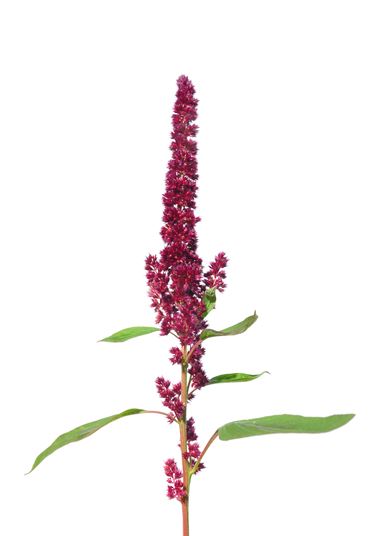
AMARANTHUS
Amaranthus caudatus
ah-mah-RAN-thus kaow-DAT-us
Description
Amaranthus is a bushy robust herb that grows up to 5' (1.5 m) tall, with stems and leaves ranging from dark greens and reds to purple. The tiny flowers bloom in cascading clusters, creating a “weeping,” waterfall effect. May be used fresh or dried.
A cultigen (known only as a crop and not found in the wild) in Peru, India and Africa.
Colors: Warm colors including reds, oranges, yellows, greens and browns
Special Care
Since the flowers have a short vase life, it is essential to either process or dry them as soon as possible. A preservative with a biocide in addition to a carbohydrate will encourage flowers to bloom fully.
Fun Facts:
Amaranthus has been grown for centuries as a food crop in South America, India and Africa and has only gained popularity for its beauty as a decorative flower in recent decades.
When grown as food, Amaranthus is highly nutritious. Its leaves may be eaten raw or cooked, like its plant cousin, spinach. Like quinoa, another plant cousin, the plant's tiny seeds may be cooked into a gelatinous porridge or ground and used for flour. They can even be popped like miniature popcorn. (No nibbling out of the flower fridge, though! Florist cultivars are grown for beauty and not nutrition, plus floral preservatives make them inedible.)
In South America, red-seeded cultivars are used to make a red food coloring named betalaina.
The name is from the Greek amarantos, meaning “unfading” and describing the flowers’ richly-hued blooms, which last for weeks while on the plant. Ironically, once cut, the blossoms fade quickly, so careful and prompt handling is essential.
Amaranthus adds a rich color and cascading line to floral arrangements, creating a striking silhouette as either a line or form flower.
A member of the Amaranthaceae (amaranth) family, related to spinach, quinoa and celosia.
Common Name
love-lies-bleeding, tassel flower, velvet flower, prince's feather
Botanical Name
Amaranthus caudatus
Pronunciation
ah-mah-RAN-thus kaow-DAT-us
Origin

Seasonal availability
Vase Life
5 - 8 Days
Fragrant
No
Ethylene
Sensitive
No
Dryable
Yes* (Hang flowers upside down to air dry, preferably with a heat source nearby; the warmer the air, the more of the flowers’ original color will be retained.)
Language of Flowers Meaning
Amaranthus flowers are used to symbolize unfading attraction.